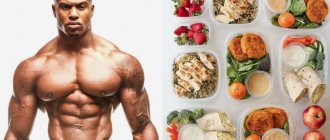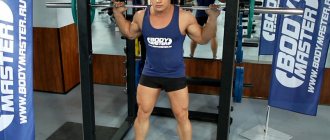About powerlifting
Powerlifting is a powerlifting sport. The main goal of all powerlifters is to perform well in their weight class in competition. Competitive disciplines represent three basic strength exercises that are familiar to every trainee:
- barbell squat;
- bench press;
- deadlift.
The athlete's achievements are assessed by how much total weight he was able to lift when performing all three exercises. Unlike bodybuilding, in powerlifting the general appearance of the athlete and the definition of his muscles do not play a role at all, because the emphasis is on the development of strength indicators.
Daily and nutritional regimen in powerlifting
Since training with heavy weights takes a lot of strength and energy, the athlete should take care of adequate nutrition and rest. The basis of a powerlifter’s diet should be “complex” carbohydrates, which replenish the body’s energy reserves and serve as fuel to repair muscle fibers damaged during training. There are enough such carbohydrates in cereals, starchy vegetables, and baked goods. Unlike bodybuilders, lifters should not be afraid of “simple” carbohydrates, which abound in sweets and baked goods, as they serve as a good source for quickly replenishing energy immediately after a workout.
In second place in the diet of a strongman are proteins, which are used as building material for damaged muscle fibers. Protein-rich foods include poultry and fish, eggs, and dairy products.
Fats come in third place in nutrition. They are necessary to maintain immunity, for the normal functioning of ligaments and joints, etc. Monounsaturated fats, which are rich in seafood, nuts, and seeds, are especially useful.
The ratio of carbohydrates, proteins and fats in a powerlifter's daily diet should be approximately 50/35/15%, respectively.
Sleep is also an integral part of a lifter's recovery. Security forces must sleep at least 8-10 hours a day, and it is advisable to allocate at least one hour for daytime sleep. After all, muscles do not grow during training, but during rest from them.
Basic principles
It would seem that everything is simple with the training program, you just need to perform basic movements from powerlifting, gradually increasing the load. But once you remember the mechanics of movement when performing a deadlift or squat with a barbell, it becomes clear that the training program should be voluminous, because you need to strengthen and develop the strength of not only the main working muscles, but also the stabilizer muscles.
In general, the universal program consists of three basic movements for a specific muscle group. The goal is to perform many sets (4-6) with heavy weights, but only a few reps. Typically, during such a workout, each movement is repeated 5 to 8 times, depending on which muscle group is loaded.
But there is another option - to combine powerlifting training and exercises for general muscle development. Despite the fact that powerlifting and bodybuilding have different goals, many famous athletes train according to the principle of two disciplines at once in order to get not only a strong body, but also beautifully developed muscles.
The choice of training program depends on your goals and level of training. Beginners should start with a general basic program that includes more than just competitive disciplines. Powerlifters who want to grow and take on increasingly larger loads can limit themselves to a standard program of 3 exercises per day. True sports fans often combine powerlifting with bodybuilding, but you still have to decide which discipline is a priority.
Basic principles of training in powerlifting:
- adequate periodization of loads to avoid overtraining syndrome;
- performing bases with heavy weight;
- performing general exercises to strengthen all muscles;
- increased rest between approaches (compared to bodybuilding);
- emphasis on reps rather than reps;
- perfect execution technique.
A beginner will have to start by mastering the technique. If in bodybuilding there is still room for imperfect technique, for example, when working with your own weight, then in powerlifting, incorrect execution can cost not only your sports career, but also your health. A ready-made program for powerlifting still remains not universal, and to achieve really good results you need an individual approach and work with a qualified coach who knows the specifics of strength training in triathlon.
Basic metabolism is the amount of energy that the body spends on basic functions: breathing, blood circulation, the course of biochemical reactions at rest, as well as performing household or work activities.
However, for an athlete, especially a powerlifter, whose training involves producing a huge amount of physical work, the amount of energy expended during his training is also important, since without taking into account this amount of energy expenditure, the body, receiving less energy, plastic and other biologically active substances, will gradually degrade.
First, this will be expressed in a loss in the rate of strength gains, in a slowdown in the growth of muscle mass, in an increase in the amount of fat deposited under the skin, and then in a clear deterioration in the functional state, that is, in an increase in the symptoms of overexertion or overtraining.
We are talking here, as you might guess, about taking into account the energy expenditure that the body produces when you train. These energy expenditures must be included in the total caloric cost of your daily (or daily) diet. Is it possible to calculate them? The experiments I conducted in the Research Department of EAM Sport Service with leading strength athletes allowed me to determine the average values of these energy expenditures and propose a certain formula for practical use, which will be presented below.
To begin with, let's remember that physical activity can be aerobic (low-intensity running in nature or on a treadmill, riding a bicycle, a stationary bicycle ergometer, doing work on a stepper or a machine that simulates running), as well as anaerobic (this is all strength work carried out with barbell, dumbbells, exercise machines). More significant for a powerlifter will be the energy expenditure incurred during aerobic work, as it is associated with a sustained increase in heart rate (HR) and the use of fatty acids for energy supply.
So, if you want to know how many kilocalories per minute you will spend walking at a fast pace on a treadmill, you should keep in mind that for every 10 kg of your own weight, when performing work near the lower limit of the aerobic heart rate zone, the body will spend approximately 0. 8 kilocalories per minute. In other words, if you weigh 100 kg, then in 1 minute when working of this nature you will lose 8 kilocalories. By multiplying this value by the number of minutes spent on the treadmill, you will get the total amount of energy spent for this aerobic workout.
If we are talking about a power load carried out in a standard mode (set - pause, and so on), then your energy expenditure will be somewhat lower - for every 10 kg of your own body weight you will spend about 0.7 kilocalories per minute. So, if you weigh 100 kg and spend 60 minutes on the lifting platform on a given day, then your expenses for this workout will be:
0.7 x 100 = 7 kcal per minute 7 kcal x 60 minutes = 420 kcal
So, you must add the value of energy expenditure during each workout to the amount of basal metabolism and the amount of energy expenditure on household or industrial activities. In practice, this is done like this: you calculate the basal metabolic rate, then the amount of energy consumed at home and at work. After this, you should calculate the average energy expenditure per week for your lifting and other workouts, and divide this amount by 7 to determine your average daily exercise expenditure. It is this average daily value that is added to the previously obtained values. It is from this amount of energy that you should proceed when planning the inclusion of protein, carbohydrate and fatty foods in your diet, that is, determining the basic diet.
Previously, we already agreed that fairly strict ratios should be maintained between the consumption of proteins, fats and carbohydrates in the daily diet. Moreover, these ratios are valid not only for the entire volume of food taken per day; it's about balancing each individual meal. Fortunately, when talking about the nutrition of an athlete who is concerned about maintaining the required proportions between macronutrients, it is quite logical to ask: “What if he takes protein supplements? After all, any protein supplement is quite significantly “skewed” in composition towards protein? There is good news for you here: if you take proteins as a means of improving protein status, and drink such cocktails between main portions of food, then you should not particularly worry about this balance - the main task is to balance proteins, fats and carbohydrates in a separate serving of regular food.
Food groups and their accounting
Let's look at the simplest and most common model of this approach. To do this, we first divide all food products (of course, those that have a certain biological value for the athlete) into separate groups, and then formulate a requirement for combining these products in a separate serving of food. Food groups
- Products of a predominantly protein nature (lean meat, fish, eggs) . The preference of a lifter athlete should be chicken breasts, turkey, and lean beef. Any fish that contains fats, mainly “light”, with a large amount of unsaturated fatty acids, can be used, since its fats do not have the same tendency as meat to be deposited under human skin. Next: eggs should be taken whole, since the yolk of an egg contains more protein than its white. Switching to egg whites is only advisable during periods when the athlete is trying to enter a lower weight category and, therefore, is forced to limit dietary fat intake to a minimum.
- Products of a predominantly protein nature (low-fat and low-fat dairy products). It is no coincidence that I emphasize the importance of a low fat percentage in dairy products. Let's look at an example: if you prefer milk with a fat content of 3.5%, then, as a rule, it contains no more than 2.6% protein and, therefore, it will be predominantly a fat product. But if you drink milk with 0.5% fat content, or kefir with 1% fat content, then this will already be a predominantly protein product, since the protein content in it will be from 2.5% and higher, depending on the type of product.
- Carbohydrate-protein products (cereals, grains and products made from them). In essence, we are talking about bakery, cereal, baked goods and flour products. The rule here is quite simple - you should choose products from the least processed grains possible. That is, choose coarse bread instead of white, or better yet, with the inclusion of whole cereal grains; choose pasta made from dark flour rather than high-quality white flour; if possible and willing, try to include coarse porridges (oatmeal, wheat, millet, barley, pearl barley and brown rice) in your diet.
- Products predominantly of a fatty nature (nuts, seeds, unrefined vegetable oil). Nuts are very rich in fats, and these fats are also light, with a large percentage of unsaturated fatty acids, which are very beneficial for your body. But keep in mind that if you take a serving of nuts, you still run the risk of exceeding your daily fat intake, and for this reason I recommend choosing two types of nuts that contain a relatively low percentage of fat, and are rich enough in good proteins that are not inferior in quality soy These are hazelnuts and almonds. Of course, it is advisable to include unroasted nuts in your diet so as not to disturb the state of fatty acids in nuts (when heated, they change their composition and become less healthy). Vegetable oil should be chosen as follows: you should use unrefined, non-deodorized oil, preferably cold pressed. If you doubt what you see on the shelf, read the ingredients. Good grades of oil indicate the percentage composition of unsaturated fatty acids, and sometimes they are even listed.
- Products are predominantly carbohydrate in nature (vegetables and legumes) . The importance of vegetables is to supply the body with very good carbohydrates (with a low glycemic index), as well as to supply the body with fiber, vitamins and minerals. The protein fraction in vegetables is insignificant, however, you should pay attention to legumes (peas, beans, lentils, beans), which can become a good source of vegetable protein, in combination with proteins of the first and second groups, giving an almost ideal amino acid profile of the food taken. Fiber plays a significant role in preventing the absorption of dietary fats (it binds them and helps remove them from the digestive tract), in the transport of the food bolus through the gastrointestinal tract (promotes intestinal motility). Root vegetables (carrots, beets) and cruciferous vegetables (turnips, radishes, radishes) are especially rich in fiber. Including significant amounts of vegetables in the diet is always a good practice, since in modern conditions we can thereby alleviate the condition of hypovitaminosis, which is the scourge of modern man.
- Carbohydrate foods (fruits, berries, fruits). This group gives us the bulk of carbohydrates, the most important ones being fructose and glucose. Moreover, some representatives of this group are rich in other biologically active substances, for example, pectins, provitamins, minerals, the importance of which in the nutrition of a serious strength athlete can hardly be overestimated.
- Water. Despite the fact that this is a seemingly completely insignificant part of the diet, water plays a vital role for an athlete. First of all, it should be remembered that the human body consists of at least 60% liquid media (blood, lymph, internal contents of cells, extracellular fluid). Optimal hydration (that is, providing the body with enough water) is a serious problem, because when there is a lack of drinking water, the body tries to maintain fluid balance and retains water produced during the active biochemical reactions that occur during strenuous muscle activity. At the same time, all toxins and impurities that remain in the bladder and kidneys (!) are filtered out of the “waste” water in the renal tubules, creating a serious risk for the athlete of sand and stones. Moreover, water is one of the richest and most essential sources of minerals. Unfortunately, there are not enough of them in ordinary drinking water, so it is recommended to drink mineral water. It also needs to be chosen accordingly - preference should be given to alkaline mineral waters, since they help to “alkalize” the body’s shift to the acidic side, which is formed during intense strength training. You know that near-maximum power stress is carried out due to the anaerobic oxidation of glycogen with the formation of lactic acid, this shifts the acid-base balance of the body to the acidic side. Acidity in the body slows down the recovery process and interferes with effective training. It is recommended to drink at least one glass of mineral water in addition to the water we drink throughout the day. The total amount of water you drink can be roughly determined by the following formula: for every 100 g of protein in your diet, you should take at least 1 liter of plain water (in addition to first courses, teas or other drinks).
Now let's get back to balancing an individual portion of food. So, leading nutritionists quite reasonably believe that in order for a separate portion of food to be balanced, it is necessary that it includes at least one representative of each of the food groups listed above. That is, for example, breakfast should consist of a piece of meat with porridge, cottage cheese, vegetable salad and, say, an apple or banana, as well as a glass of mineral water or green tea. Lunch and dinner should be structured in exactly the same way. In this case, a relative (I repeat, relative!) balance is achieved between proteins, fats, carbohydrates, minerals and vitamins. Unfortunately, we can only regulate the entire imbalance with nutritional supplements.
Optimal balanced nutrition plan
Further on, what should be the volume of a single portion of food. Let's think about this together. If, say, you have decided on the amount of daily energy expenditure in the amount of 3000 kilocalories, then traditional breakfast, lunch and dinner should include the volume of products that would give you as much as 1000 kilocalories in each individual serving! I must tell you that, unfortunately, modern ideas about physiological, balanced and adequate nutrition are not absorbed into this value of the energy cost of an individual serving of food.
Imagine what will happen: the body will digest and assimilate from this amount what it needs to cover momentary energy expenditure and plastic processes, and the rest, being in your system, will represent a rather tasty morsel for the body in the sense that all the excess calories will be can turn into fat deposits. This is, unfortunately, what happens when a single serving of food is too large in volume and caloric cost. The potential for the growth of fat deposits is enormous. This is not the best option for a powerlifter, especially for one who is trying to compete in a certain weight class.
Therefore, it is necessary to resort to other, more scientific and more rational dietary patterns. The only possible model under these conditions is a fractional, frequent feeding model. It is more physiological, and involves eating not three times a day, but 5-6 times, at equal intervals. At the same time, the energy cost of an individual portion becomes significantly smaller - about 500-600 kilocalories, that is, by the time of the next meal the body has no unused reserve, and the tendency to accumulate excess in the form of fat under the skin is significantly reduced, and with a more accurate calculation of everything what you eat may be eliminated altogether. Of course, this requires both practice and careful monitoring of whether you are growing muscle or fat during your training.
So that you have an idea of how to practically organize such nutrition, we will give an example of what the nutrition of a powerlifter weighing 95 kg, who needs to enter the weight category up to 90 kg, might look like (hence, a slight limitation in the caloric cost of the daily diet is assumed). This diet was built on the principle of fractional frequent meals (5-6 times a day in relatively small portions), using nutritional supplements and regular food. Calculation of the amount of food consumed per daily caloric intake of 2750 kcal (training day) and 2500 kcal (non-training day) Protein foods:
- 2 cups skim milk
- 250 g low-fat cottage cheese
- 250 g of any boiled meat
- 250 g of any fish
Carbohydrate products:
- 4 slices bran or whole grain bread
- 0.5 cups Hercules (dry, brew)
- 0.5 cups buckwheat or rice porridge
- 1 tea cup young corn, peas or beans
Vegetable and fruit group products:
- 100 g cabbage or lettuce
- 50 g red beets
- 1 carrot
- 2 cucumbers
- 2 tomatoes
- 1 banana
- 4 medium sized apples
Sports nutrition products:
- 30 g "Turbo Protein" IRONMAN
- 60 g protein F80 IRONMAN
- 8 capsules BCAA IRONMAN
- 2 tablets “Vita Formula” IRONMAN
- 12 capsules "Amino 3600" IRONMAN
Meal breakdown:
- Breakfast: egg, cottage cheese, porridge, fruit, 4 capsules “Amino 3600”
- Second breakfast: 30 g F80 with water or skim milk
- Lunch: meat with porridge (buckwheat or rice), vegetable salads, fruits, 4 Amino 3600 capsules, 1 Vita Formula tablet
- Before training: 30 minutes before – banana, 15 minutes before – 4 BCAA capsules
- Afternoon snack: 30 g F80 with water or skim milk (on a training day - 15 minutes after training)
- Immediately after training: 4 BCAA capsules (before protein intake)
- Dinner: fish with vegetables, fruit, 4 capsules “Amino 3600”
- 40 minutes before bedtime: 30 g “Turbo-Protein”, 1 tablet “Vita Formula”
Attention, on non-training days exclude from the above diet:
- porridge
- banana
- 1 apple
Between lunch and dinner on a non-training day, take a cocktail of 30 g of F80.
Of course, this is a particular example, given only as an illustration of how all the above principles and approaches can be implemented in practice. It is based on a real case of developing a nutritional diet for a powerlifter who needed to enter the 90 kg weight category within a month and a half by correcting body fat (at that stage he had 16.6% body fat, and this allowed without loss of muscle mass and , therefore, performance, adjust total body weight). As a result, when he was weighed, his body weight was determined to be 89.8 kg, while caliperometric measurements showed that the amount of fat under the skin at the end of this diet was only 11.95%.
It is clear that in order to maintain a stable body weight in the off-season, he was offered a slightly different scheme, where the percentage of protein consumed was increased (due to the inclusion of another 50 g of whey 90 percent IRONMAN isolate in the diet) and, consequently, the daily caloric intake increased by about 200 -220 kilocalories. Naturally, in each specific case, the diet can be built taking into account the financial capabilities of the athlete, the nature and direction of the mesocycle in which he is currently located.
Where to start, or the importance of penetration
Getting to know powerlifting begins with climbing. This is the name given to the process of determining the maximum weight with which an athlete can work without harm to health. The algorithm for performing such a test to determine the workload is as follows.
1. Take a barbell and equip it with plates, according to your physical form. For some beginners this may be 30 kg, for others – 50 or more.
2. Perform one repetition of each of the three competition exercises.
3. Increase the load by 10 kg and repeat the execution.
4. Then add more pancakes and do the exercises again.
5. Increase the mass of the apparatus until the athlete is able to perform the exercise without someone else’s help. This is the maximum weight.
You can do all the exercises in one day. In general, you will have to devote an entire training session to driving. You need to rest between repetitions; rest can be three minutes or more, depending on your physical fitness.
Some beginners believe that penetration is optional. In fact, without knowing his personal repetition maximum (RM), a person will not be able to determine the working weight with which he will train effectively but safely.
No person can constantly train at maximum load, because such an approach inevitably leads to burnout or overtraining. To avoid this, but at the same time not stop progress, all training in powerlifting is divided into three types:
- light – with a weight of 50% of the personal maximum;
- moderate severity - about 60-70% PM;
- heavy - up to 90% PM.
The load alternates between weeks or from exercise to exercise, if the entire base is worked out during one session.
Universal training plan
The following program is one of the most common; most amateur powerlifters practice it. However, every amateur sooner or later begins to strive to become professionals, so the training program must be revised over time.
Basic principles:
- weekly load change;
- 1-2 basic strength exercises per day;
- maximum 4 exercises per session.
The number of repetitions will depend on individual characteristics. On average, movements with heavy weights are performed 5-8 times, depending on experience and maximal max.
The first training week is structured as follows.
- Workout: bench press (5x5, 80% of RM), barbell squat (60% of weight, 5x5), French bench press (3-4x8).
- Workout: deadlift (80%, 5x5), hyperextension or crunches (3 sets maximum times), standing biceps curl (3x10).
- Workout: bench press (60%, 5x5), squat (80% RM, 5x5), bent-over dumbbell swings (3-4x10).
The load in auxiliary movements, such as biceps curls and French presses, is selected individually, according to sensations.
The plan for the second week is as follows.
- First session: squat (60%), bench press (70%), standing press (4-5x10).
- Second session: deadlift (75%), shrugs (5x15), close-grip bench press (5x10).
- Third lesson: squats (75%), calf raises in a machine or with dumbbells (3x20), barbell rows to the collarbones (3x10).
In these plans, the base (barbell squat, bench press and deadlift) is always performed in 5 sets of 5 repetitions. In brackets is the weight from the personal maximum that needs to be exercised on a certain day.
Third week:
- 1 – squat (85%), bench press (50%, 4x15);
- 2 – deadlift (75%), bent-over barbell row (3-4x10);
- 3 – squat (50%), bench press (75-80%), close-grip bench press (4x8-10).
In the third week, the number of exercises decreases, as the body needs to rest, reducing the load.
In addition, the third week program can be used by beginners who have just begun to master powerlifting. These exercises can be combined with work on machines and your own weight to develop general physical performance.
No. 1 Training program
First day:
- Heavy Press
- Light squats
- If you still have some strength left, you can do a French press or dips.
Second day:
- Deadlift
- If there is strength left, then we do hyperextensions and biceps curls + hammers.
The third day:
- Light press
- Squats are heavy
- If there is strength left, then we work on the deltas - swings in an incline, to the sides, in front of us.
Training weights will depend on the results of your progress, that is, on the maximum performance. The number of repetitions and method of execution will depend on the cycle you use (the Russian and Verkhoshansky cycles are very famous in powerlifting). Professionals know how to use these cycles, but for beginners, we recommend contacting a trainer who will guide you in the right direction.
Plan to Increase Bench Press
One of the most problematic disciplines in powerlifting is the bench press. This is due to the small size of the pectoral muscles and the relatively small initial burden. Deadlifts and squats use approximately the same muscles, so performance in these disciplines increases much faster. If you need to increase your bench press results in a short time, the following training plan is recommended. This program is designed for 2 months, the emphasis is on the development of the chest, triceps and biceps, the lower part of the body is lightly loaded. The plan is not suitable for beginners; it is designed for intermediate and advanced levels of training.
Monday Tuesday):
- Ab crunches;
- bench press;
- wide grip push-ups;
- butterfly pinch;
- pull-ups;
- standing biceps curls;
- extension and flexion of the wrists while sitting with weights.
The number of repetitions for all exercises is 3x10 times. In this program, the bench press is always performed 5x5, the weight is 80% of the maximum.
Second lesson (Wednesday or Thursday):
- raising your legs on a bench;
- seated press;
- swings with weights to the sides;
- broach with a bar;
- pull-ups;
- Bent-over dumbbell row;
- pulling the block to the chest.
Do everything again 3x10.
Third lesson:
- hyperextension;
- deadlift (80% of 1RM);
- bench press (close grip);
- dips;
- French bench press;
- squat (60% weight).
The number of repetitions of all movements except deadlifts and squats is 3x10. The triathlon base is performed 5x5.
An increase in strength when performing bench presses and growth of the pectoral muscles are noticeable already in the fourth week of such training.
Program for beginners
Quite often, young people who have never worked out in a gym before decide to start with powerlifting. The following plan is designed specifically for those who have no training experience or have been training for about 2-3 months in a bodybuilding program.
Primary requirements:
- lack of significant excess weight;
- healthy spine;
- classes in the gym (the plan includes work on the simulators).
Essentially, this is a standard plan aimed at building muscle mass, but with an emphasis on all-around strength disciplines. It is recommended to study according to this plan for 2-3 months, and then you can move on to the universal program for powerlifting described above.
Day one - emphasis on developing the lower body and pectoral muscles:
- twisting or hyperextension;
- barbell squat;
- bench press;
- lunges with a barbell or dumbbells;
- seated chest press;
- bending and extending legs in the simulator.
Since the class is designed for beginners who have never worked out in the gym before, passing is not required. Working weight is determined individually. Here you don’t need to strive to take the maximum at once, so you should perform squats and bench presses with weights that will allow you to perform 8-10 repetitions.
Second day – emphasis on arm muscles:
- leg raises on parallel bars;
- classic push-ups;
- pull-ups (reverse grip);
- French bench press;
- hammer curls;
- lying down pullover;
- flexion and extension of the wrists while sitting.
On the third day, the muscles of the shoulder girdle and back work:
- hyperextension;
- deadlift;
- standing barbell press from the chest;
- pulling the upper block behind the head;
- broach;
- pulling the block to the chest.
All exercises in the plan for beginners are performed in 3 sets of 10-15 times. The workload should be increased every week by 10% - this way you can achieve fairly rapid progress without overloading the body.
Before and after training
Powerlifting cannot be rushed, so you must approach the activity responsibly and thoroughly.
- Always start with a warm-up. Since powerlifting involves a large axial load on the spine, you should start with an impact load - running or fast walking. Then be sure to stretch your back and lower back, for example, by performing yoga warm-up movements or the “boat”. This is very important, since an insufficiently warmed body and an unprepared spine may not withstand work with heavy weights.
- The second important nuance is rest between approaches. Since powerlifting involves working almost to the limit of your capabilities, you can and should rest. If in bodybuilding the average rest lasts about two minutes, in triathlon it increases to five or more. In general, an athlete should rest as much as they need to recover their strength. You will often see a powerlifter in the gym performing three exercises within an hour and a half - this is completely normal.
- When training according to a plan that focuses on the base with heavy weights, it is recommended to enlist the support of a partner. This is especially important for beginners, because they cannot always correctly calculate their strength and assess their level of training.
- The squat and deadlift technique in powerlifting is somewhat different from what bodybuilders do. It can take a long time to describe the nuances, so the best solution would be to consult with a professional triathlete or work with a coach. However, for beginners the weight is light at first, so you can perform movements using the classical technique. As the load increases, each person begins to feel their body better and grasp the necessary nuances in performance.
- Cooling down is optional, but is one of the useful tools in shaping an athletic body. Nothing bad will happen if you don’t do it, but with a cool-down, the muscles recover faster. Everyone decides for themselves whether they need to stretch after a strength session, but experienced athletes still recommend spending an extra 20 minutes and doing a cool-down - the body will be grateful.
- An athletic belt and elastic knee braces when working with heavy weights are not a whim, but very useful additional equipment. Moreover, it is recommended to use a belt and knee bandages from the first steps in powerlifting. In addition to fixing the joints and lower back in the desired position, the protection reduces the risk of injury.
And lastly, there is no need to chase weights on the barbell; progress should occur smoothly and gradually. Regular exercise will definitely bring results.
Powerlifting Exercises
Exercises in powerlifting do not differ in variety. The most important thing is a gradual increase in weight and very clear and competent adherence to technique. The technique must be honed to perfection, because the work is carried out with a lot of weight, and violations in the execution of exercises can lead to serious injuries.
Squats with a barbell on your shoulders, how to do it correctly
This exercise is a basic exercise for lifters. It engages the muscles of the entire body, but mostly the legs, buttocks, core and abs.
Technique:
- Grasp the bar with both hands, bring your shoulder blades together, place the bar on your middle trapezius and rear deltoids. Stand under the barbell, distributing your weight evenly on both legs. Remove the barbell from the bar and take two steps back with your feet approximately shoulder-width apart or slightly wider. This will be the starting position.
- As you inhale, bending your knees, we squat. We keep the back straight, without bending, only the natural lordosis in the lower back remains. We direct our gaze straight ahead. We concentrate on the tension in the leg muscles. The body leans forward slightly, the knees do not go beyond the line of the toes. The legs stand firmly on the entire foot.
- At the exit, we straighten our legs and stand in the starting position.
- Repeat the required number of times.
Basic exercises for lifters
A variation of the exercise is the front squat. The technique is the same, only we place the barbell on the upper part of the chest and deltas. In this case, the emphasis is on working the quadriceps.
Video: Squats with a barbell on the shoulders - strength training
Close grip bench press
The exercise targets the shoulders, forearms and trapezius.
A
Technique:
- We lie down on the bench, grab the barbell with an overhand grip, placing our hands slightly narrower than our shoulders (at a distance of about 20–30 centimeters from each other).
- We remove the barbell from the bar and smoothly lower it to the chest.
- Slowly raise the barbell up as you exhale, fully straightening your arms.
- As you inhale, lower the barbell to your chest again.
- Repeat as many times as necessary.
Bent-overs with a barbell on your shoulders
This exercise perfectly works the back muscles, gluteus maximus, spinal extensor muscles, and abdominal muscles.
V
Technique:
- We stand straight, legs slightly wider than shoulders, slightly bent to the knees, toes slightly turned away from each other.
- We take a barbell and place it on the upper trapezius and rear deltoids.
- As you inhale, moving your pelvis back, bend down with the barbell. Movement occurs only in the hip joints. Ideally, you should bend over at a 90-degree angle until your torso is parallel to the floor.
- We return to the starting position as we exhale.
- Repeat as many times as necessary.
This exercise can be quite traumatic; beginners are advised to exclude it or perform it with an empty bar.
Video: Forward Bends with a Barbell on the Shoulders
Deadlift
A classic exercise for bodybuilding and powerlifting. It is a basic exercise and works muscles such as:
- spinal extensors;
- latissimus dorsi muscles;
- upper back muscles;
- buttocks;
- thigh muscles;
- quadriceps;
- muscles of the forearms.
Exercise to work the muscles of the back, legs and forearms
Technique:
- Starting position: feet shoulder-width apart, parallel to each other, toes on the bar of the barbell lying on the floor. We grab the bar with an overhand grip, with our wrists slightly wider than shoulder-width apart, our arms perpendicular to the floor, and our shoulders positioned directly above the bar.
- As you exhale, we lift the barbell smoothly and evenly, the bar sliding along the legs. Raising the barbell above the knees, straighten the torso as much as possible and bring the shoulder blades together, concentrating on working the back muscles.
- Moving the pelvis back, we gradually lower ourselves to the starting position, also sliding the bar along the legs.
- Once the pancakes touch the floor, repeat the required number of times.
During the exercise, the lower back should be slightly arched at all times, and the gaze should be directed upward. There is no need to make sudden jerks; we work extremely smoothly and calmly.
Video: Deadlift
Hyperextension
This exercise works great on the back muscles and the back of the thighs. It is performed in a special simulator.
Back exercise
Technique:
- We customize the simulator to suit your height. It is important that your feet rest comfortably on the bolsters. We take the starting position: straightened up in the simulator, hands behind the head.
- We lower the body down at a right angle to the legs while inhaling. The back remains straight.
- As you exhale, raise your body to the starting position, tensing the muscles of your legs and buttocks.
- Repeat as many times as necessary.
Video: Hyperextension technique
Straight-legged barbell row
An exercise that trains the gluteal muscles and hamstrings, as well as the back extensors and lower back.
Differs from the classic deadlift in that the legs remain straight.
Technique:
- Starting position: stand straight, grab the bar with a straight grip, palms shoulder-width apart.
- Keeping your back straight, bend forward as low as possible while inhaling. If it turns out with a straight back until the body is parallel to the floor, it’s good; if the back begins to round, we linger in an accessible position.
- As you inhale, we return to the starting position.
- We repeat the required number of times.











